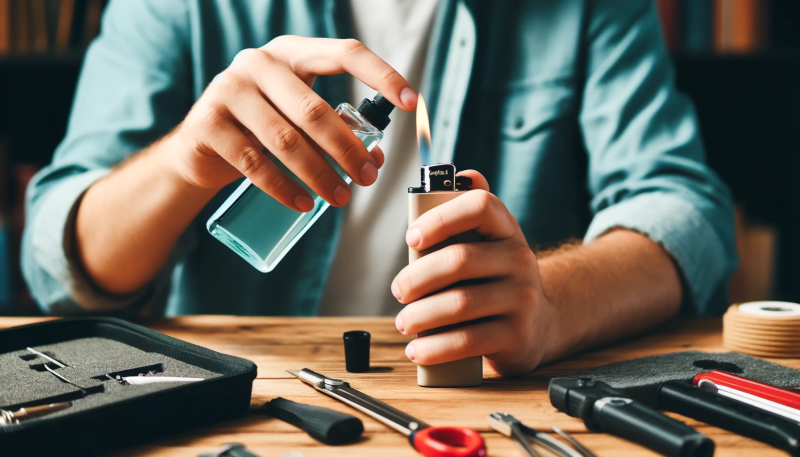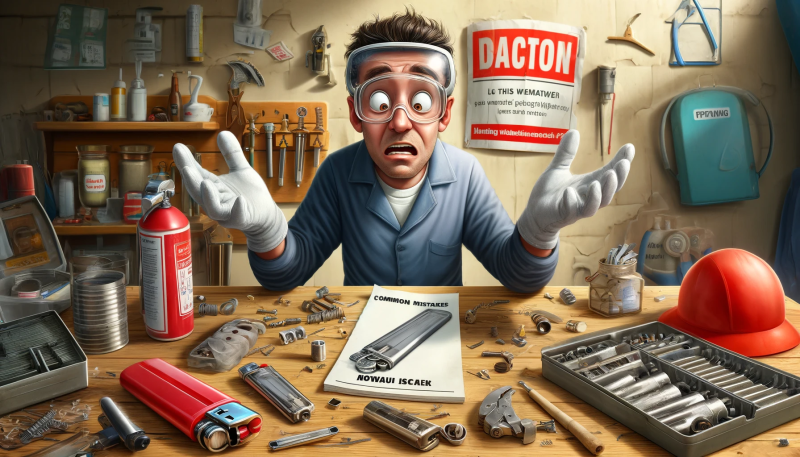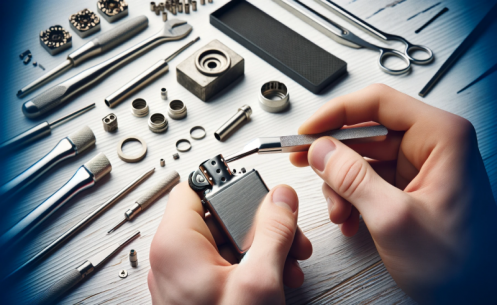11 minuten leestijd
Why is it important to maintain your lighter?
Maintaining your lighter is essential for reliable and long-lasting operation. Imagine, you're outside on a stormy night, ready to light your campfire. However, your lighter fails you because you never maintained it. A nightmare, right? By regularly maintaining your lighter, you ensure it's always ready for use.
In addition, safety plays a major role. Poorly maintained lighters can lead to accidents such as gas leaks or overheating. This can be dangerous, especially if you're near flammable materials. Make sure to follow the proper maintenance steps to minimize these risks.
Reliability and Longevity
A well-maintained lighter lasts longer and performs better. This means fewer unexpected problems and a consistent flame when you need it most.
Safety Considerations
Improper use and maintenance of lighters can lead to hazardous situations. Regular inspection and cleaning help prevent potential hazards.
Various types of lighters and their maintenance

Lighters come in various types and sizes, and each type requires specific maintenance. Let's take a look at the most common types of lighters and how to best maintain them.
Gas Lighters
Gas lighters are popular for their ease of use and reliability. They run on butane gas and can be refilled. For the maintenance of gas lighters, it is important to regularly check and clean the burner and the flint.
Electric Lighters
Electric lighters are a modern choice that do not require fuel. They run on a rechargeable battery. Ensure to keep the contact points clean and charge the battery regularly to optimize performance.
Plasma Lighters
Plasma lighters use an electric arc to create a flame. They are windproof and ideal for outdoor activities. Maintenance includes cleaning the electrodes and safely charging the battery.
Zippo Lighters
Zippo lighters are iconic and known for their durability. They require regular maintenance, such as replacing the wick and refilling the fuel. Keeping the lighter clean is also essential.
Clipper Lighters
Clipper lighters are versatile and popular due to their refillable design and replaceable flint. Regular maintenance such as replacing the flint and cleaning the exterior ensures a longer lifespan.
Bic Lighters
Bic lighters are disposable items that require minimal maintenance. Although they are designed to be discarded over time, regular cleaning can improve performance.
Storm Lighters
Storm lighters are designed to function under extreme weather conditions. Maintenance includes charging or refilling the fuel and cleaning the burner to ensure a strong flame.
View our range of lighters here!
Steps for cleaning your lighter

Cleaning your lighter is a simple but important task. Here are the steps to follow:
Materials Needed
- Small brush
- Compressed air (optional)
- Cloth
- Isopropyl alcohol
Safety Precautions
Before you start cleaning your lighter, ensure it's turned off and not leaking any fuel. Work in a well-ventilated area and avoid open flames.
- Use a small brush to remove dirt and residue from the burner.
- Wipe the exterior clean with a cloth soaked in isopropyl alcohol.
- For hard-to-reach areas, you can use compressed air to blow away dust and dirt.
Maintenance of Gas Lighters
Refilling Gas Lighters
- Turn the lighter upside down and locate the filling valve.
- Press the gas canister against the filling valve and hold it for a few seconds.
- Check for leaks and place the lighter upright to stabilize.
Replacing Flint
- Remove the flint wheel.
- Place a new flint into the holder.
- Replace the flint wheel and test the lighter.
Maintenance of Electric Lighters
Charging the Battery
- Connect the lighter to a charger via the USB port.
- Allow the lighter to fully charge before using it again.
Cleaning the Contact Points
- Use a cotton swab soaked in isopropyl alcohol to clean the contact points.
- Ensure the lighter is completely dry before using it again.
Maintenance of Plasma Arc Lighters
Caring for the Electrodes
- Gently clean the electrodes with a small brush.
- Avoid bending or damaging the electrodes.
Safe Charging
- Always use the provided charger to prevent overheating.
- Keep the lighter away from water while charging.
Maintenance of Zippo Lighters
Replacing the Wick
- Remove the insert from the lighter.
- Pull out the old wick and replace it with a new one.
- Reinsert the insert and refill the lighter with fuel.
Refilling with Fuel
- Open the bottom flap of the lighter.
- Fill the lighter with fuel until it's full.
- Close the flap and test the lighter.
Maintenance of Clipper Lighters
Replacing Flint and Wick
- Remove the flint holder.
- Place a new flint and a new wick if necessary.
- Replace the flint holder and test the lighter.
Cleaning the Exterior
- Wipe the exterior clean with a cloth.
- Use a little isopropyl alcohol if stubborn dirt is present.
Maintenance of Bic Lighters
Limited Maintenance
Bic lighters are designed to be thrown away once the fuel is depleted. However, you can keep them clean by wiping the exterior and removing dirt around the flint wheel.
Disposable Product
Once a Bic lighter is empty, it's time to replace it.
Maintenance of Storm Lighters
Charging or Refilling
- Follow the manufacturer's instructions for charging or refilling.
- Ensure the lighter is fully charged or refilled before using it.
Cleaning the Burner
- Use a small brush to clean the burner.
- Ensure no dirt or residue remains that could affect the flame.
Common Mistakes in Lighter Maintenance

Overfilling Gas Lighters
It's tempting to overfill your gas lighter to prolong its use, but this can be dangerous. Overfilling can lead to gas leaks and unsafe situations. Always fill the lighter according to the manufacturer's instructions.
Using the Wrong Fuel
Not all lighters use the same fuel. It's important to use the correct fuel to prevent damage to the lighter. Always read the manufacturer's instructions and use the recommended fuel.
Tips and Tricks for Long-lasting Lighter Use
- Regular Inspection and Maintenance: Make it a habit to regularly inspect and clean your lighter. This helps detect and address any issues early.
- Lighter Storage: Store your lighter in a cool, dry place. Avoid exposure to extreme temperatures and direct sunlight, as this can affect your lighter's performance.
When is it time to replace your lighter?
Sometimes, despite proper maintenance, it's time to replace your lighter. Here are some signs that your lighter needs replacing:
- Signs of Wear and Tear: If your lighter shows signs of wear and tear, such as a worn-out wick or damaged parts, it's time to replace it.
- Safety Considerations: If you notice your lighter is no longer safe to use, such as with gas leaks or overheating, replace it immediately.
Frequently Asked Questions about Lighter Maintenance
How often should I clean my lighter?
This depends on how often you use the lighter. For regular use, weekly cleaning is advisable. For less frequent use, you can perform maintenance monthly.
Can I use any type of fuel for my lighter?
No, it's important to use the correct fuel recommended by the manufacturer. Using the wrong fuel can damage the lighter and cause hazardous situations.
Conclusion
Maintaining your lighter is crucial for longevity and safe operation. By regularly maintaining and cleaning it, you can ensure your lighter is always ready for use. Remember to follow the proper maintenance steps for the specific type of lighter you have and be alert to signs that it's time to replace your lighter.
By following these simple steps, you can enjoy a reliable and safe lighter, whether you're lighting a campfire, candles, or your barbecue. A well-maintained lighter makes your life much easier and safer!


